Kellogg's Structure, Culture, and Organizational Performance Report
VerifiedAdded on 2020/10/22
|10
|2565
|77
Report
AI Summary
This report provides an in-depth analysis of Kellogg's workplace structure and culture, examining how these elements contribute to organizational performance. It begins by defining the modern workplace and highlighting Kellogg's approach to employee motivation and engagement. The report then details Kellogg's organizational structure, corporate culture, and the factors that influence performance, such as innovation, motivation, communication, and training. It also explores Handy's culture model and Maslow's hierarchy of needs to understand how Kellogg addresses employee needs and fosters a positive work environment. The conclusion emphasizes the crucial role of organizational structure and culture in achieving business objectives. This report showcases how Kellogg's strategies enhance performance and achieve its business goals.
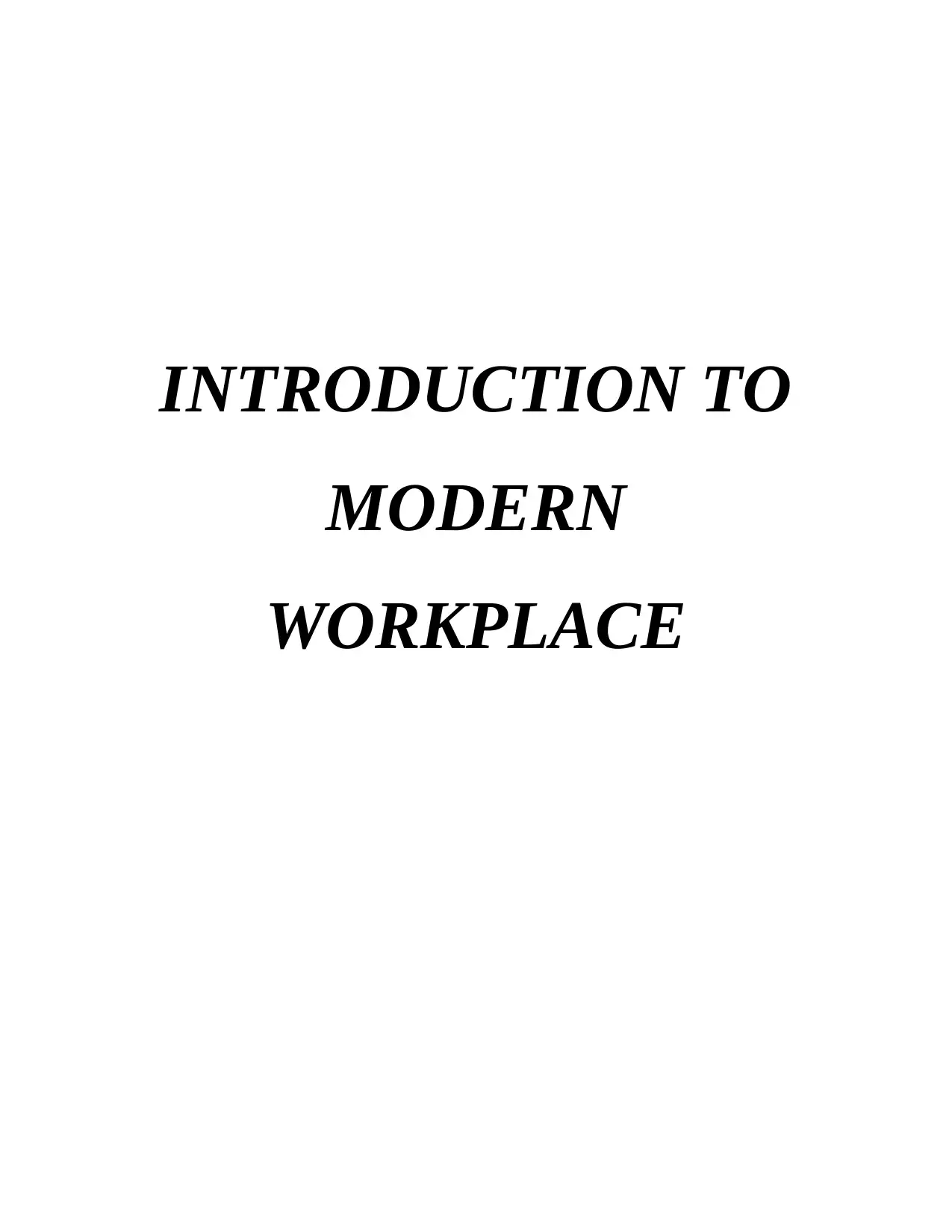
INTRODUCTION TO
MODERN
WORKPLACE
MODERN
WORKPLACE
Paraphrase This Document
Need a fresh take? Get an instant paraphrase of this document with our AI Paraphraser
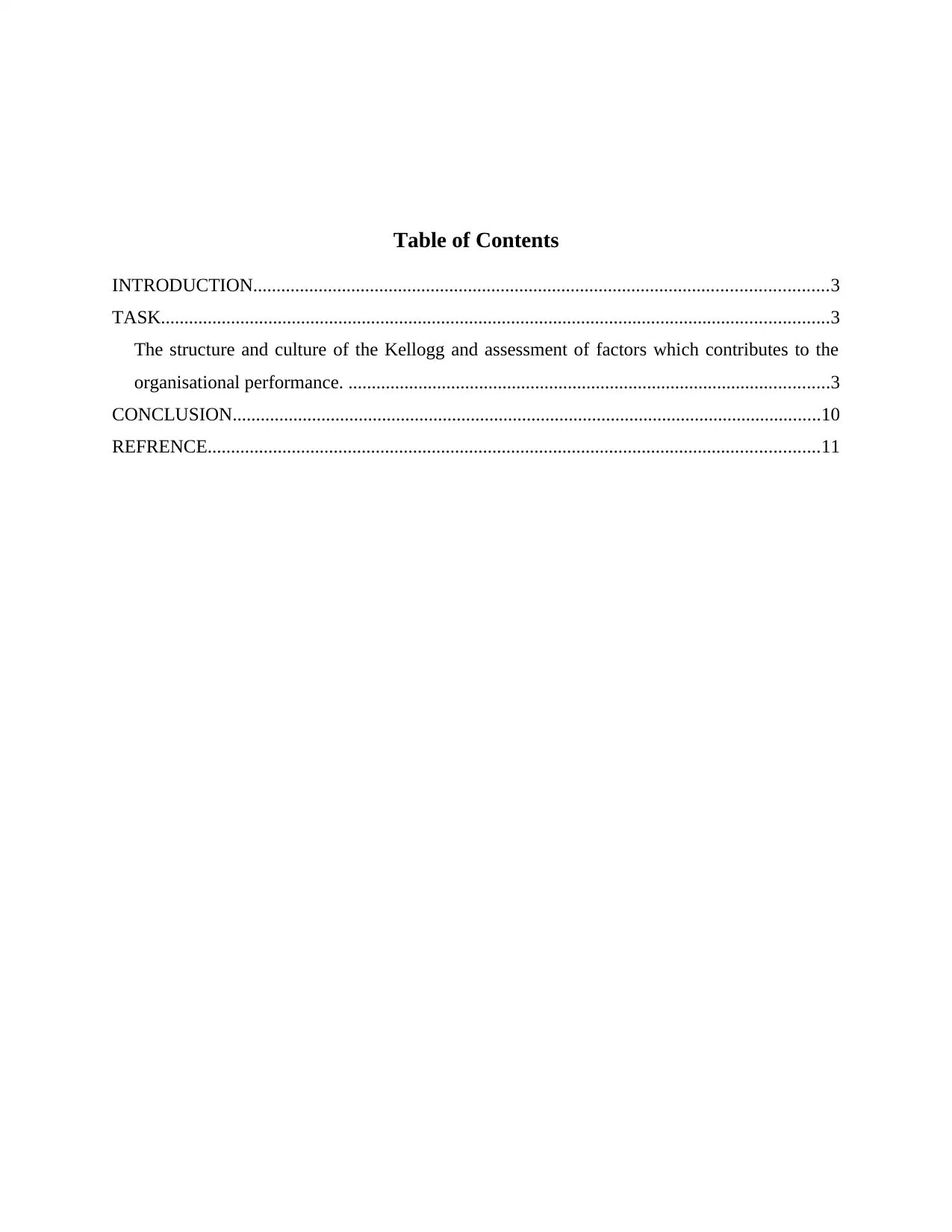
Table of Contents
INTRODUCTION...........................................................................................................................3
TASK...............................................................................................................................................3
The structure and culture of the Kellogg and assessment of factors which contributes to the
organisational performance. .......................................................................................................3
CONCLUSION..............................................................................................................................10
REFRENCE...................................................................................................................................11
INTRODUCTION...........................................................................................................................3
TASK...............................................................................................................................................3
The structure and culture of the Kellogg and assessment of factors which contributes to the
organisational performance. .......................................................................................................3
CONCLUSION..............................................................................................................................10
REFRENCE...................................................................................................................................11
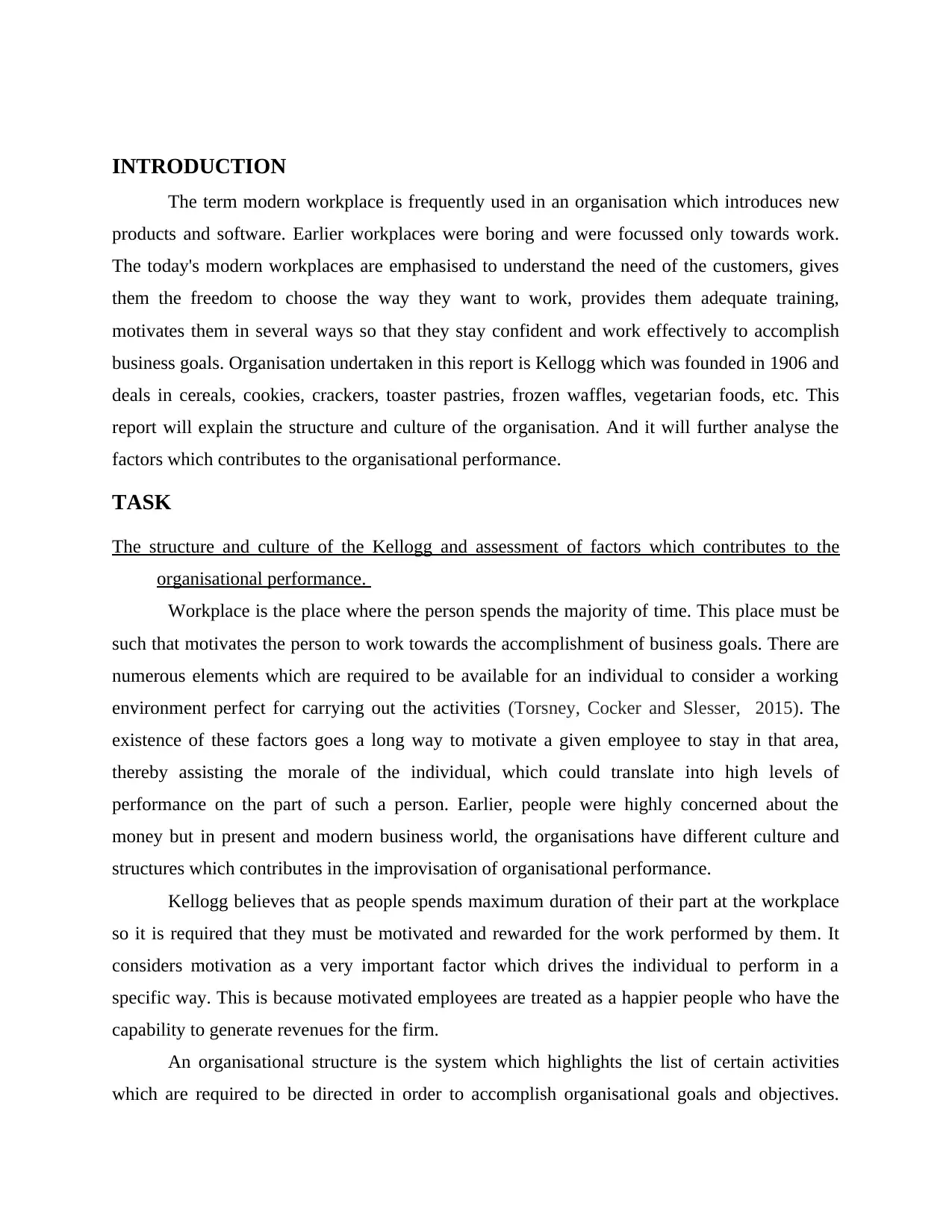
INTRODUCTION
The term modern workplace is frequently used in an organisation which introduces new
products and software. Earlier workplaces were boring and were focussed only towards work.
The today's modern workplaces are emphasised to understand the need of the customers, gives
them the freedom to choose the way they want to work, provides them adequate training,
motivates them in several ways so that they stay confident and work effectively to accomplish
business goals. Organisation undertaken in this report is Kellogg which was founded in 1906 and
deals in cereals, cookies, crackers, toaster pastries, frozen waffles, vegetarian foods, etc. This
report will explain the structure and culture of the organisation. And it will further analyse the
factors which contributes to the organisational performance.
TASK
The structure and culture of the Kellogg and assessment of factors which contributes to the
organisational performance.
Workplace is the place where the person spends the majority of time. This place must be
such that motivates the person to work towards the accomplishment of business goals. There are
numerous elements which are required to be available for an individual to consider a working
environment perfect for carrying out the activities (Torsney, Cocker and Slesser, 2015). The
existence of these factors goes a long way to motivate a given employee to stay in that area,
thereby assisting the morale of the individual, which could translate into high levels of
performance on the part of such a person. Earlier, people were highly concerned about the
money but in present and modern business world, the organisations have different culture and
structures which contributes in the improvisation of organisational performance.
Kellogg believes that as people spends maximum duration of their part at the workplace
so it is required that they must be motivated and rewarded for the work performed by them. It
considers motivation as a very important factor which drives the individual to perform in a
specific way. This is because motivated employees are treated as a happier people who have the
capability to generate revenues for the firm.
An organisational structure is the system which highlights the list of certain activities
which are required to be directed in order to accomplish organisational goals and objectives.
The term modern workplace is frequently used in an organisation which introduces new
products and software. Earlier workplaces were boring and were focussed only towards work.
The today's modern workplaces are emphasised to understand the need of the customers, gives
them the freedom to choose the way they want to work, provides them adequate training,
motivates them in several ways so that they stay confident and work effectively to accomplish
business goals. Organisation undertaken in this report is Kellogg which was founded in 1906 and
deals in cereals, cookies, crackers, toaster pastries, frozen waffles, vegetarian foods, etc. This
report will explain the structure and culture of the organisation. And it will further analyse the
factors which contributes to the organisational performance.
TASK
The structure and culture of the Kellogg and assessment of factors which contributes to the
organisational performance.
Workplace is the place where the person spends the majority of time. This place must be
such that motivates the person to work towards the accomplishment of business goals. There are
numerous elements which are required to be available for an individual to consider a working
environment perfect for carrying out the activities (Torsney, Cocker and Slesser, 2015). The
existence of these factors goes a long way to motivate a given employee to stay in that area,
thereby assisting the morale of the individual, which could translate into high levels of
performance on the part of such a person. Earlier, people were highly concerned about the
money but in present and modern business world, the organisations have different culture and
structures which contributes in the improvisation of organisational performance.
Kellogg believes that as people spends maximum duration of their part at the workplace
so it is required that they must be motivated and rewarded for the work performed by them. It
considers motivation as a very important factor which drives the individual to perform in a
specific way. This is because motivated employees are treated as a happier people who have the
capability to generate revenues for the firm.
An organisational structure is the system which highlights the list of certain activities
which are required to be directed in order to accomplish organisational goals and objectives.
⊘ This is a preview!⊘
Do you want full access?
Subscribe today to unlock all pages.

Trusted by 1+ million students worldwide
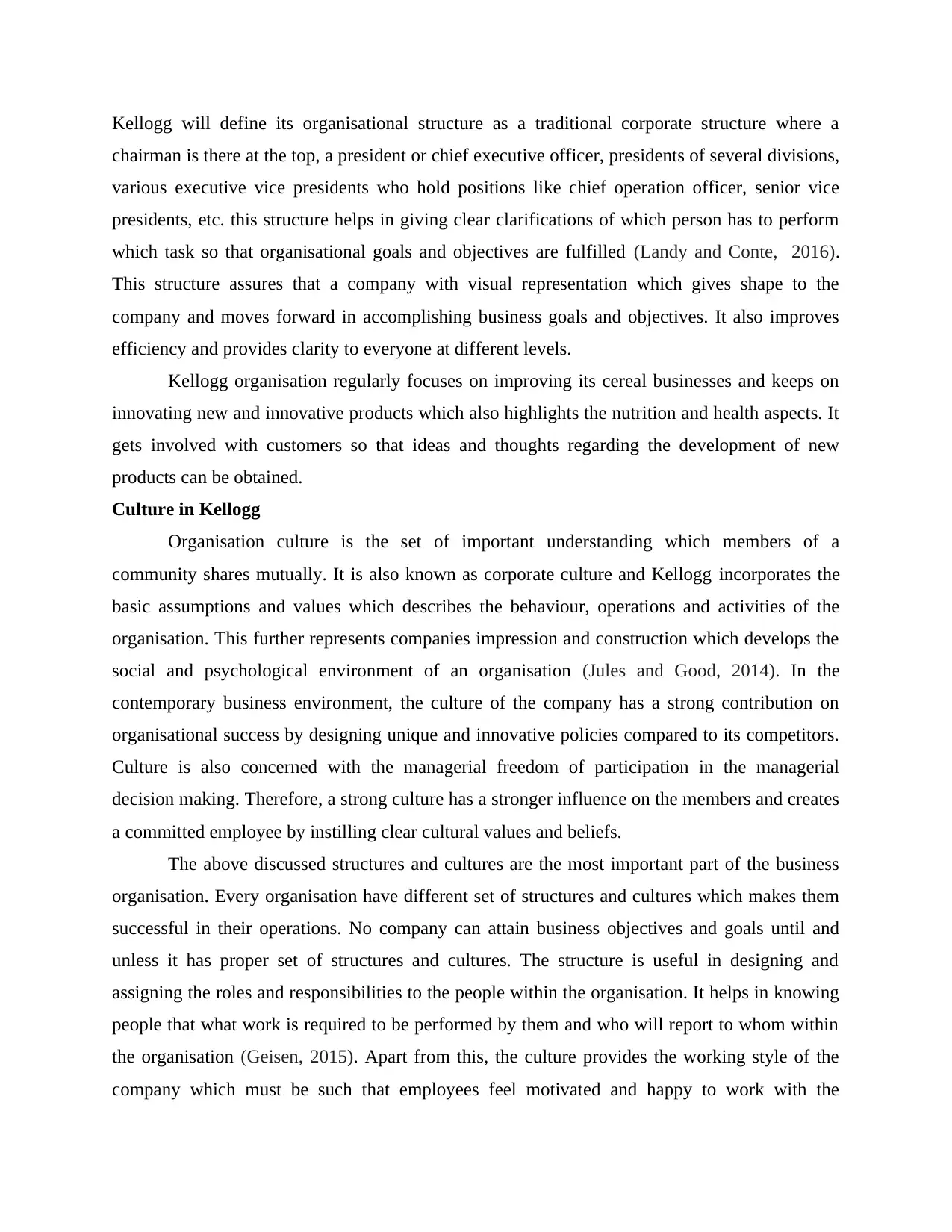
Kellogg will define its organisational structure as a traditional corporate structure where a
chairman is there at the top, a president or chief executive officer, presidents of several divisions,
various executive vice presidents who hold positions like chief operation officer, senior vice
presidents, etc. this structure helps in giving clear clarifications of which person has to perform
which task so that organisational goals and objectives are fulfilled (Landy and Conte, 2016).
This structure assures that a company with visual representation which gives shape to the
company and moves forward in accomplishing business goals and objectives. It also improves
efficiency and provides clarity to everyone at different levels.
Kellogg organisation regularly focuses on improving its cereal businesses and keeps on
innovating new and innovative products which also highlights the nutrition and health aspects. It
gets involved with customers so that ideas and thoughts regarding the development of new
products can be obtained.
Culture in Kellogg
Organisation culture is the set of important understanding which members of a
community shares mutually. It is also known as corporate culture and Kellogg incorporates the
basic assumptions and values which describes the behaviour, operations and activities of the
organisation. This further represents companies impression and construction which develops the
social and psychological environment of an organisation (Jules and Good, 2014). In the
contemporary business environment, the culture of the company has a strong contribution on
organisational success by designing unique and innovative policies compared to its competitors.
Culture is also concerned with the managerial freedom of participation in the managerial
decision making. Therefore, a strong culture has a stronger influence on the members and creates
a committed employee by instilling clear cultural values and beliefs.
The above discussed structures and cultures are the most important part of the business
organisation. Every organisation have different set of structures and cultures which makes them
successful in their operations. No company can attain business objectives and goals until and
unless it has proper set of structures and cultures. The structure is useful in designing and
assigning the roles and responsibilities to the people within the organisation. It helps in knowing
people that what work is required to be performed by them and who will report to whom within
the organisation (Geisen, 2015). Apart from this, the culture provides the working style of the
company which must be such that employees feel motivated and happy to work with the
chairman is there at the top, a president or chief executive officer, presidents of several divisions,
various executive vice presidents who hold positions like chief operation officer, senior vice
presidents, etc. this structure helps in giving clear clarifications of which person has to perform
which task so that organisational goals and objectives are fulfilled (Landy and Conte, 2016).
This structure assures that a company with visual representation which gives shape to the
company and moves forward in accomplishing business goals and objectives. It also improves
efficiency and provides clarity to everyone at different levels.
Kellogg organisation regularly focuses on improving its cereal businesses and keeps on
innovating new and innovative products which also highlights the nutrition and health aspects. It
gets involved with customers so that ideas and thoughts regarding the development of new
products can be obtained.
Culture in Kellogg
Organisation culture is the set of important understanding which members of a
community shares mutually. It is also known as corporate culture and Kellogg incorporates the
basic assumptions and values which describes the behaviour, operations and activities of the
organisation. This further represents companies impression and construction which develops the
social and psychological environment of an organisation (Jules and Good, 2014). In the
contemporary business environment, the culture of the company has a strong contribution on
organisational success by designing unique and innovative policies compared to its competitors.
Culture is also concerned with the managerial freedom of participation in the managerial
decision making. Therefore, a strong culture has a stronger influence on the members and creates
a committed employee by instilling clear cultural values and beliefs.
The above discussed structures and cultures are the most important part of the business
organisation. Every organisation have different set of structures and cultures which makes them
successful in their operations. No company can attain business objectives and goals until and
unless it has proper set of structures and cultures. The structure is useful in designing and
assigning the roles and responsibilities to the people within the organisation. It helps in knowing
people that what work is required to be performed by them and who will report to whom within
the organisation (Geisen, 2015). Apart from this, the culture provides the working style of the
company which must be such that employees feel motivated and happy to work with the
Paraphrase This Document
Need a fresh take? Get an instant paraphrase of this document with our AI Paraphraser
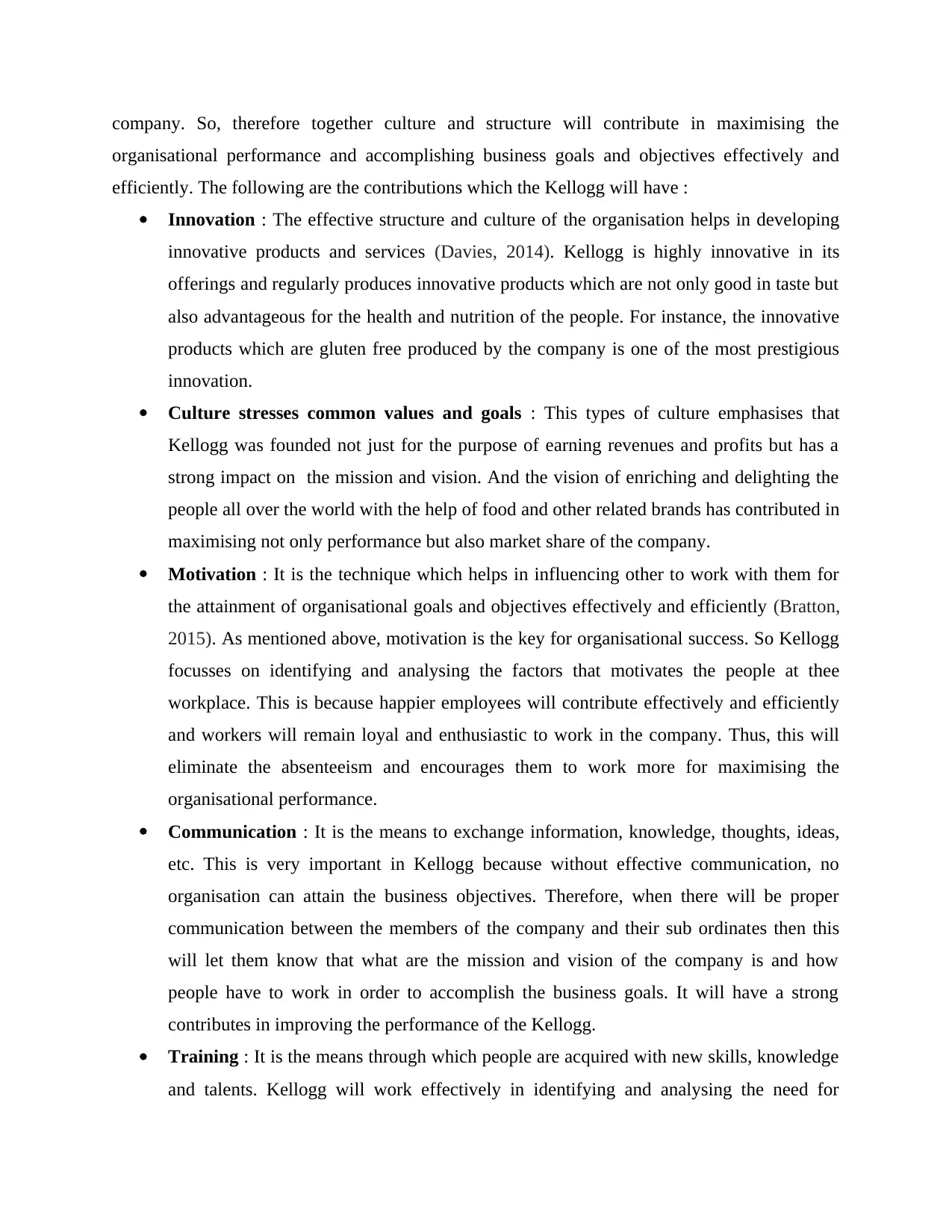
company. So, therefore together culture and structure will contribute in maximising the
organisational performance and accomplishing business goals and objectives effectively and
efficiently. The following are the contributions which the Kellogg will have :
Innovation : The effective structure and culture of the organisation helps in developing
innovative products and services (Davies, 2014). Kellogg is highly innovative in its
offerings and regularly produces innovative products which are not only good in taste but
also advantageous for the health and nutrition of the people. For instance, the innovative
products which are gluten free produced by the company is one of the most prestigious
innovation.
Culture stresses common values and goals : This types of culture emphasises that
Kellogg was founded not just for the purpose of earning revenues and profits but has a
strong impact on the mission and vision. And the vision of enriching and delighting the
people all over the world with the help of food and other related brands has contributed in
maximising not only performance but also market share of the company.
Motivation : It is the technique which helps in influencing other to work with them for
the attainment of organisational goals and objectives effectively and efficiently (Bratton,
2015). As mentioned above, motivation is the key for organisational success. So Kellogg
focusses on identifying and analysing the factors that motivates the people at thee
workplace. This is because happier employees will contribute effectively and efficiently
and workers will remain loyal and enthusiastic to work in the company. Thus, this will
eliminate the absenteeism and encourages them to work more for maximising the
organisational performance.
Communication : It is the means to exchange information, knowledge, thoughts, ideas,
etc. This is very important in Kellogg because without effective communication, no
organisation can attain the business objectives. Therefore, when there will be proper
communication between the members of the company and their sub ordinates then this
will let them know that what are the mission and vision of the company is and how
people have to work in order to accomplish the business goals. It will have a strong
contributes in improving the performance of the Kellogg.
Training : It is the means through which people are acquired with new skills, knowledge
and talents. Kellogg will work effectively in identifying and analysing the need for
organisational performance and accomplishing business goals and objectives effectively and
efficiently. The following are the contributions which the Kellogg will have :
Innovation : The effective structure and culture of the organisation helps in developing
innovative products and services (Davies, 2014). Kellogg is highly innovative in its
offerings and regularly produces innovative products which are not only good in taste but
also advantageous for the health and nutrition of the people. For instance, the innovative
products which are gluten free produced by the company is one of the most prestigious
innovation.
Culture stresses common values and goals : This types of culture emphasises that
Kellogg was founded not just for the purpose of earning revenues and profits but has a
strong impact on the mission and vision. And the vision of enriching and delighting the
people all over the world with the help of food and other related brands has contributed in
maximising not only performance but also market share of the company.
Motivation : It is the technique which helps in influencing other to work with them for
the attainment of organisational goals and objectives effectively and efficiently (Bratton,
2015). As mentioned above, motivation is the key for organisational success. So Kellogg
focusses on identifying and analysing the factors that motivates the people at thee
workplace. This is because happier employees will contribute effectively and efficiently
and workers will remain loyal and enthusiastic to work in the company. Thus, this will
eliminate the absenteeism and encourages them to work more for maximising the
organisational performance.
Communication : It is the means to exchange information, knowledge, thoughts, ideas,
etc. This is very important in Kellogg because without effective communication, no
organisation can attain the business objectives. Therefore, when there will be proper
communication between the members of the company and their sub ordinates then this
will let them know that what are the mission and vision of the company is and how
people have to work in order to accomplish the business goals. It will have a strong
contributes in improving the performance of the Kellogg.
Training : It is the means through which people are acquired with new skills, knowledge
and talents. Kellogg will work effectively in identifying and analysing the need for
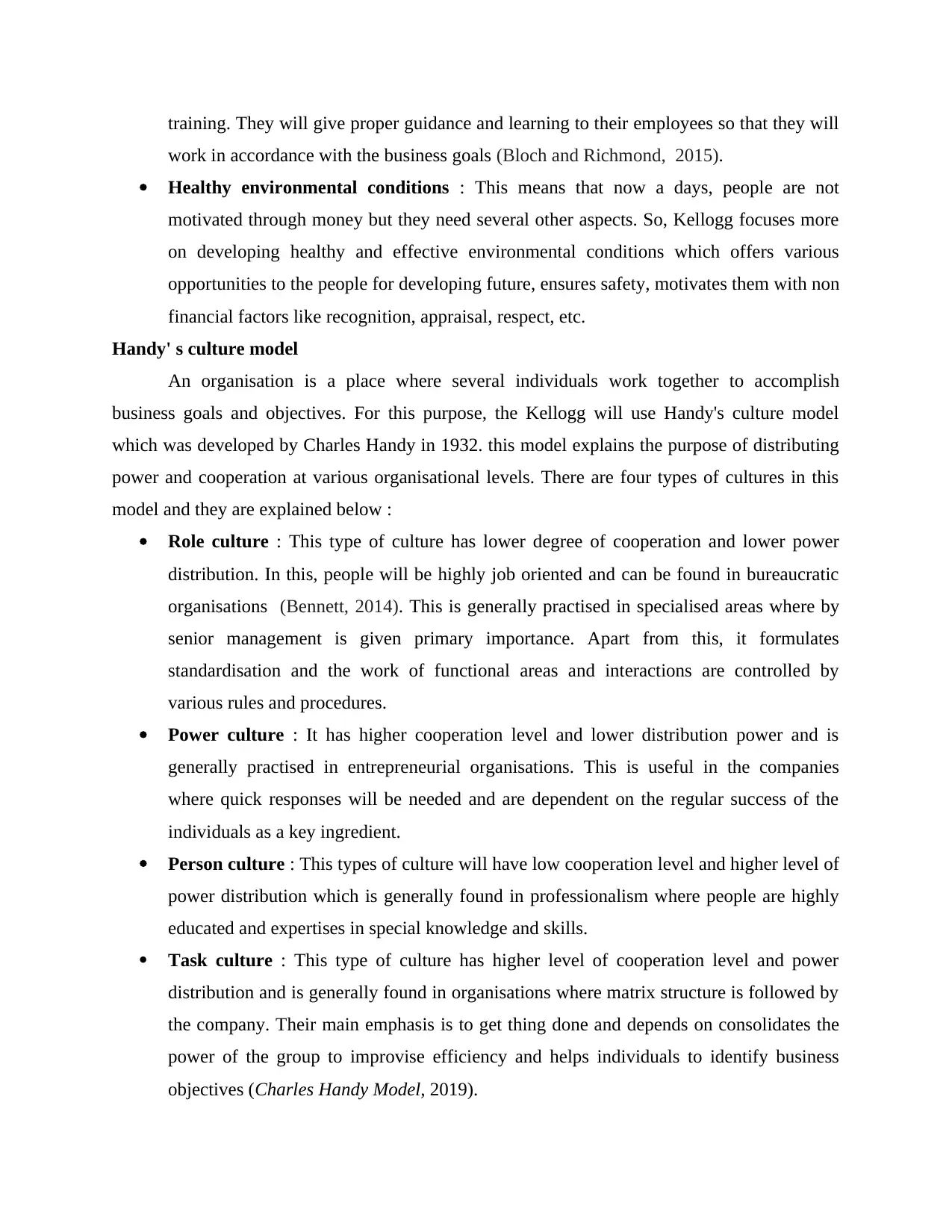
training. They will give proper guidance and learning to their employees so that they will
work in accordance with the business goals (Bloch and Richmond, 2015).
Healthy environmental conditions : This means that now a days, people are not
motivated through money but they need several other aspects. So, Kellogg focuses more
on developing healthy and effective environmental conditions which offers various
opportunities to the people for developing future, ensures safety, motivates them with non
financial factors like recognition, appraisal, respect, etc.
Handy' s culture model
An organisation is a place where several individuals work together to accomplish
business goals and objectives. For this purpose, the Kellogg will use Handy's culture model
which was developed by Charles Handy in 1932. this model explains the purpose of distributing
power and cooperation at various organisational levels. There are four types of cultures in this
model and they are explained below :
Role culture : This type of culture has lower degree of cooperation and lower power
distribution. In this, people will be highly job oriented and can be found in bureaucratic
organisations (Bennett, 2014). This is generally practised in specialised areas where by
senior management is given primary importance. Apart from this, it formulates
standardisation and the work of functional areas and interactions are controlled by
various rules and procedures.
Power culture : It has higher cooperation level and lower distribution power and is
generally practised in entrepreneurial organisations. This is useful in the companies
where quick responses will be needed and are dependent on the regular success of the
individuals as a key ingredient.
Person culture : This types of culture will have low cooperation level and higher level of
power distribution which is generally found in professionalism where people are highly
educated and expertises in special knowledge and skills.
Task culture : This type of culture has higher level of cooperation level and power
distribution and is generally found in organisations where matrix structure is followed by
the company. Their main emphasis is to get thing done and depends on consolidates the
power of the group to improvise efficiency and helps individuals to identify business
objectives (Charles Handy Model, 2019).
work in accordance with the business goals (Bloch and Richmond, 2015).
Healthy environmental conditions : This means that now a days, people are not
motivated through money but they need several other aspects. So, Kellogg focuses more
on developing healthy and effective environmental conditions which offers various
opportunities to the people for developing future, ensures safety, motivates them with non
financial factors like recognition, appraisal, respect, etc.
Handy' s culture model
An organisation is a place where several individuals work together to accomplish
business goals and objectives. For this purpose, the Kellogg will use Handy's culture model
which was developed by Charles Handy in 1932. this model explains the purpose of distributing
power and cooperation at various organisational levels. There are four types of cultures in this
model and they are explained below :
Role culture : This type of culture has lower degree of cooperation and lower power
distribution. In this, people will be highly job oriented and can be found in bureaucratic
organisations (Bennett, 2014). This is generally practised in specialised areas where by
senior management is given primary importance. Apart from this, it formulates
standardisation and the work of functional areas and interactions are controlled by
various rules and procedures.
Power culture : It has higher cooperation level and lower distribution power and is
generally practised in entrepreneurial organisations. This is useful in the companies
where quick responses will be needed and are dependent on the regular success of the
individuals as a key ingredient.
Person culture : This types of culture will have low cooperation level and higher level of
power distribution which is generally found in professionalism where people are highly
educated and expertises in special knowledge and skills.
Task culture : This type of culture has higher level of cooperation level and power
distribution and is generally found in organisations where matrix structure is followed by
the company. Their main emphasis is to get thing done and depends on consolidates the
power of the group to improvise efficiency and helps individuals to identify business
objectives (Charles Handy Model, 2019).
⊘ This is a preview!⊘
Do you want full access?
Subscribe today to unlock all pages.

Trusted by 1+ million students worldwide
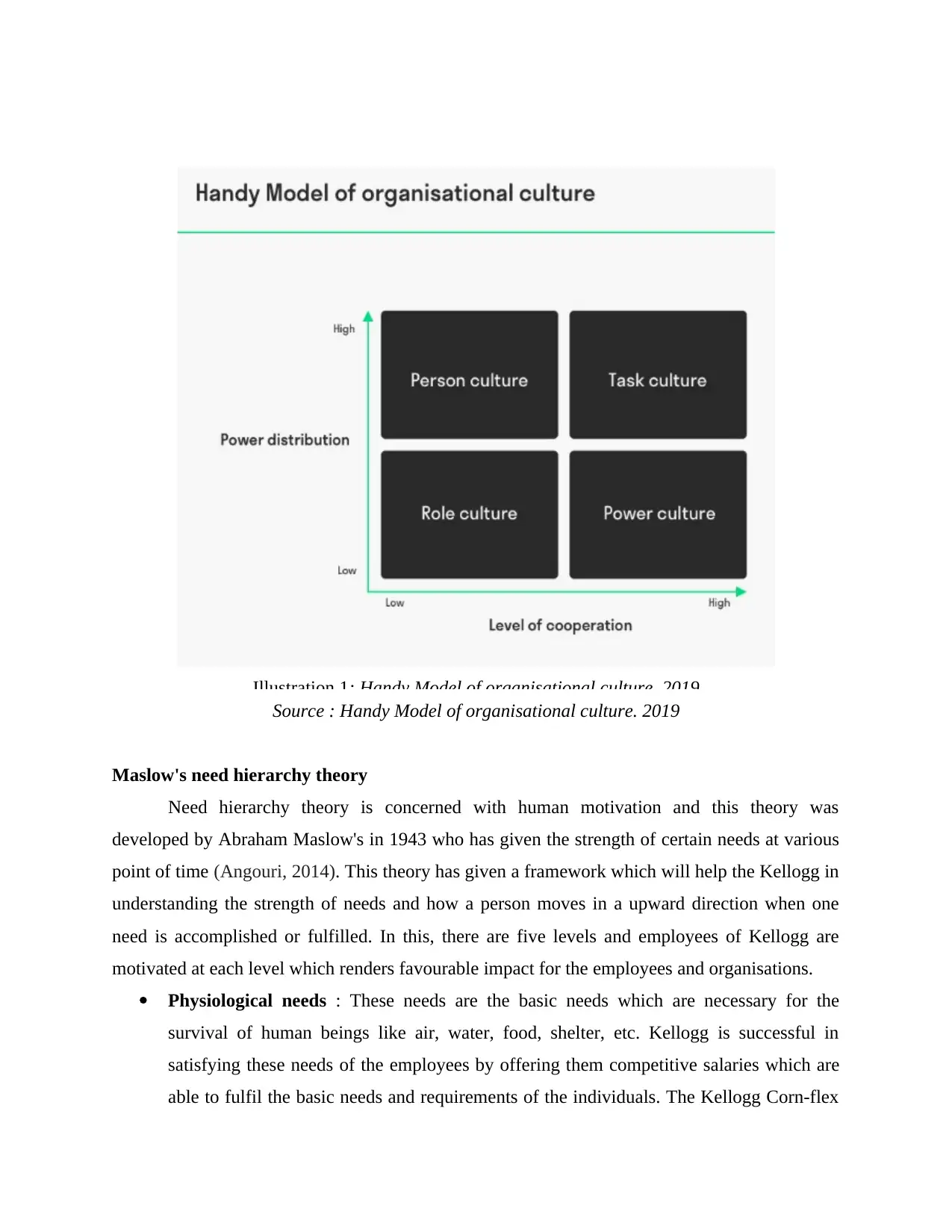
Source : Handy Model of organisational culture. 2019
Maslow's need hierarchy theory
Need hierarchy theory is concerned with human motivation and this theory was
developed by Abraham Maslow's in 1943 who has given the strength of certain needs at various
point of time (Angouri, 2014). This theory has given a framework which will help the Kellogg in
understanding the strength of needs and how a person moves in a upward direction when one
need is accomplished or fulfilled. In this, there are five levels and employees of Kellogg are
motivated at each level which renders favourable impact for the employees and organisations.
Physiological needs : These needs are the basic needs which are necessary for the
survival of human beings like air, water, food, shelter, etc. Kellogg is successful in
satisfying these needs of the employees by offering them competitive salaries which are
able to fulfil the basic needs and requirements of the individuals. The Kellogg Corn-flex
Illustration 1: Handy Model of organisational culture. 2019
Maslow's need hierarchy theory
Need hierarchy theory is concerned with human motivation and this theory was
developed by Abraham Maslow's in 1943 who has given the strength of certain needs at various
point of time (Angouri, 2014). This theory has given a framework which will help the Kellogg in
understanding the strength of needs and how a person moves in a upward direction when one
need is accomplished or fulfilled. In this, there are five levels and employees of Kellogg are
motivated at each level which renders favourable impact for the employees and organisations.
Physiological needs : These needs are the basic needs which are necessary for the
survival of human beings like air, water, food, shelter, etc. Kellogg is successful in
satisfying these needs of the employees by offering them competitive salaries which are
able to fulfil the basic needs and requirements of the individuals. The Kellogg Corn-flex
Illustration 1: Handy Model of organisational culture. 2019
Paraphrase This Document
Need a fresh take? Get an instant paraphrase of this document with our AI Paraphraser
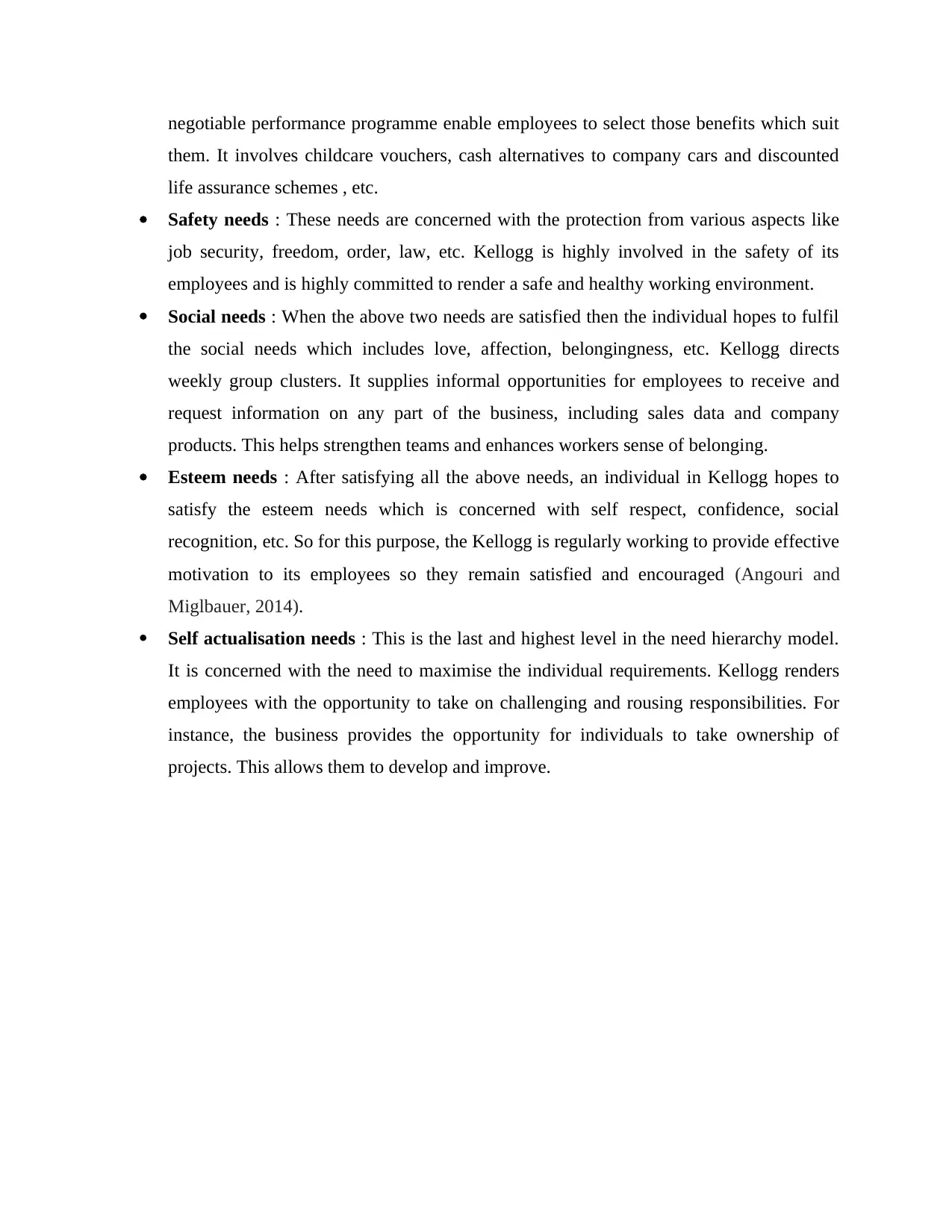
negotiable performance programme enable employees to select those benefits which suit
them. It involves childcare vouchers, cash alternatives to company cars and discounted
life assurance schemes , etc.
Safety needs : These needs are concerned with the protection from various aspects like
job security, freedom, order, law, etc. Kellogg is highly involved in the safety of its
employees and is highly committed to render a safe and healthy working environment.
Social needs : When the above two needs are satisfied then the individual hopes to fulfil
the social needs which includes love, affection, belongingness, etc. Kellogg directs
weekly group clusters. It supplies informal opportunities for employees to receive and
request information on any part of the business, including sales data and company
products. This helps strengthen teams and enhances workers sense of belonging.
Esteem needs : After satisfying all the above needs, an individual in Kellogg hopes to
satisfy the esteem needs which is concerned with self respect, confidence, social
recognition, etc. So for this purpose, the Kellogg is regularly working to provide effective
motivation to its employees so they remain satisfied and encouraged (Angouri and
Miglbauer, 2014).
Self actualisation needs : This is the last and highest level in the need hierarchy model.
It is concerned with the need to maximise the individual requirements. Kellogg renders
employees with the opportunity to take on challenging and rousing responsibilities. For
instance, the business provides the opportunity for individuals to take ownership of
projects. This allows them to develop and improve.
them. It involves childcare vouchers, cash alternatives to company cars and discounted
life assurance schemes , etc.
Safety needs : These needs are concerned with the protection from various aspects like
job security, freedom, order, law, etc. Kellogg is highly involved in the safety of its
employees and is highly committed to render a safe and healthy working environment.
Social needs : When the above two needs are satisfied then the individual hopes to fulfil
the social needs which includes love, affection, belongingness, etc. Kellogg directs
weekly group clusters. It supplies informal opportunities for employees to receive and
request information on any part of the business, including sales data and company
products. This helps strengthen teams and enhances workers sense of belonging.
Esteem needs : After satisfying all the above needs, an individual in Kellogg hopes to
satisfy the esteem needs which is concerned with self respect, confidence, social
recognition, etc. So for this purpose, the Kellogg is regularly working to provide effective
motivation to its employees so they remain satisfied and encouraged (Angouri and
Miglbauer, 2014).
Self actualisation needs : This is the last and highest level in the need hierarchy model.
It is concerned with the need to maximise the individual requirements. Kellogg renders
employees with the opportunity to take on challenging and rousing responsibilities. For
instance, the business provides the opportunity for individuals to take ownership of
projects. This allows them to develop and improve.
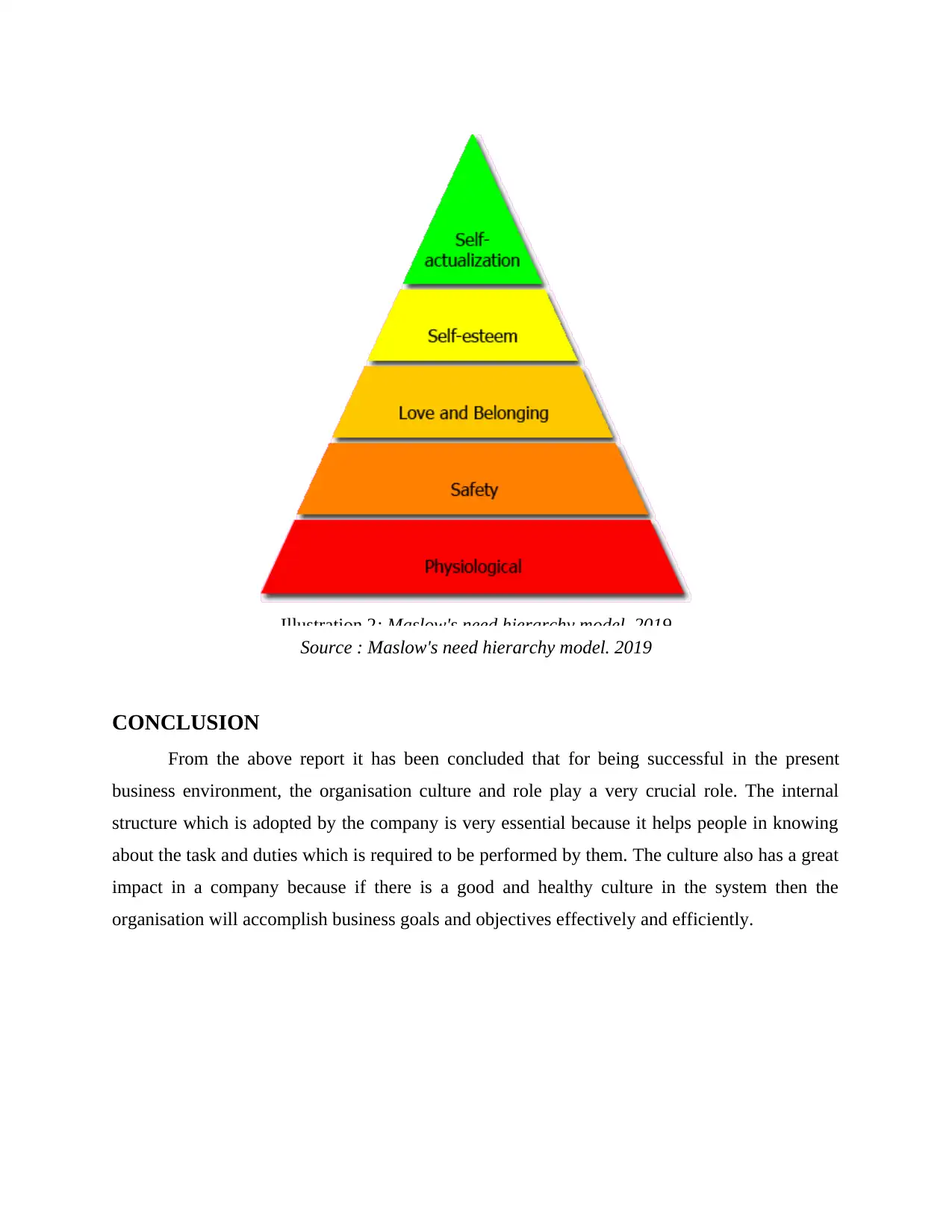
Source : Maslow's need hierarchy model. 2019
CONCLUSION
From the above report it has been concluded that for being successful in the present
business environment, the organisation culture and role play a very crucial role. The internal
structure which is adopted by the company is very essential because it helps people in knowing
about the task and duties which is required to be performed by them. The culture also has a great
impact in a company because if there is a good and healthy culture in the system then the
organisation will accomplish business goals and objectives effectively and efficiently.
Illustration 2: Maslow's need hierarchy model. 2019
CONCLUSION
From the above report it has been concluded that for being successful in the present
business environment, the organisation culture and role play a very crucial role. The internal
structure which is adopted by the company is very essential because it helps people in knowing
about the task and duties which is required to be performed by them. The culture also has a great
impact in a company because if there is a good and healthy culture in the system then the
organisation will accomplish business goals and objectives effectively and efficiently.
Illustration 2: Maslow's need hierarchy model. 2019
⊘ This is a preview!⊘
Do you want full access?
Subscribe today to unlock all pages.

Trusted by 1+ million students worldwide
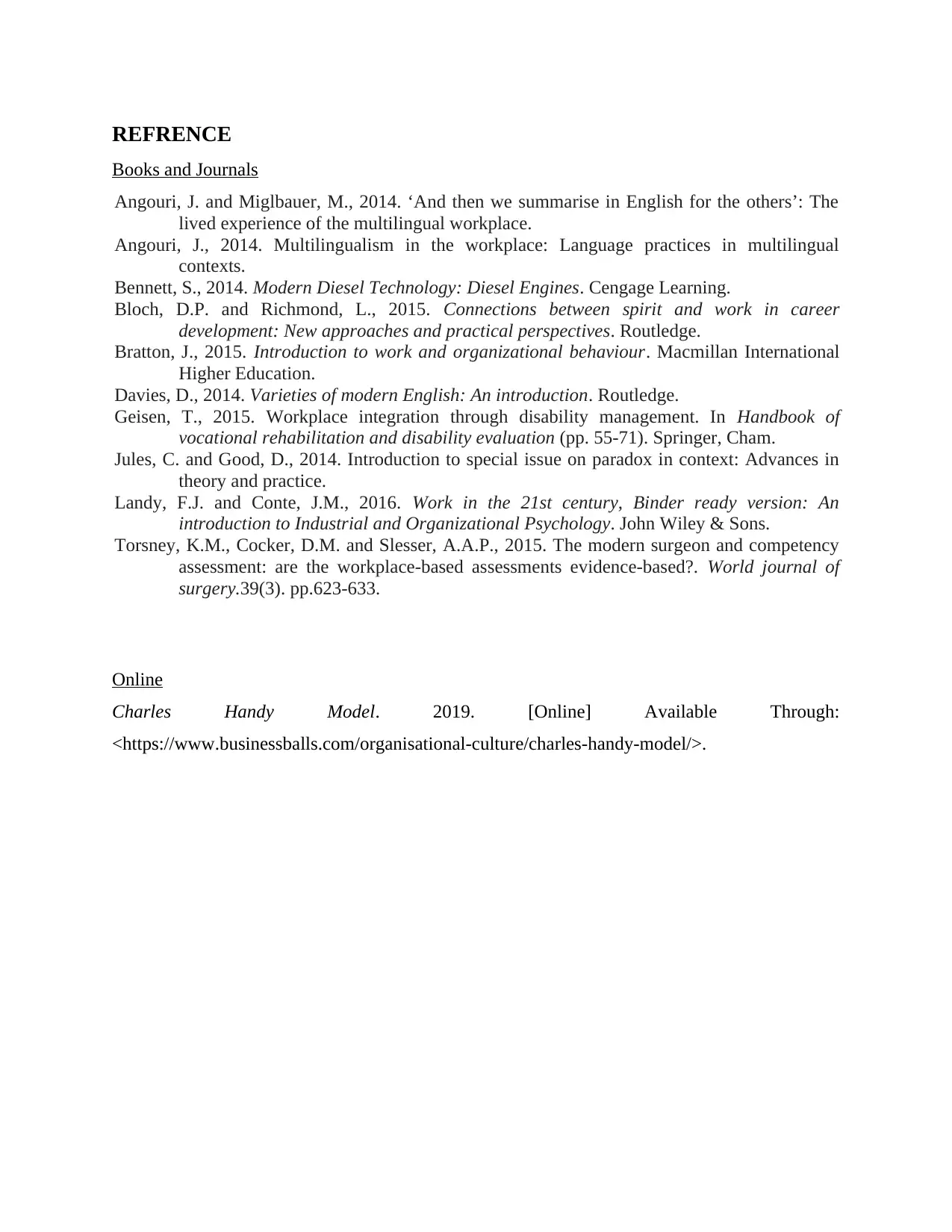
REFRENCE
Books and Journals
Angouri, J. and Miglbauer, M., 2014. ‘And then we summarise in English for the others’: The
lived experience of the multilingual workplace.
Angouri, J., 2014. Multilingualism in the workplace: Language practices in multilingual
contexts.
Bennett, S., 2014. Modern Diesel Technology: Diesel Engines. Cengage Learning.
Bloch, D.P. and Richmond, L., 2015. Connections between spirit and work in career
development: New approaches and practical perspectives. Routledge.
Bratton, J., 2015. Introduction to work and organizational behaviour. Macmillan International
Higher Education.
Davies, D., 2014. Varieties of modern English: An introduction. Routledge.
Geisen, T., 2015. Workplace integration through disability management. In Handbook of
vocational rehabilitation and disability evaluation (pp. 55-71). Springer, Cham.
Jules, C. and Good, D., 2014. Introduction to special issue on paradox in context: Advances in
theory and practice.
Landy, F.J. and Conte, J.M., 2016. Work in the 21st century, Binder ready version: An
introduction to Industrial and Organizational Psychology. John Wiley & Sons.
Torsney, K.M., Cocker, D.M. and Slesser, A.A.P., 2015. The modern surgeon and competency
assessment: are the workplace-based assessments evidence-based?. World journal of
surgery.39(3). pp.623-633.
Online
Charles Handy Model. 2019. [Online] Available Through:
<https://www.businessballs.com/organisational-culture/charles-handy-model/>.
ANDY MODEL
Books and Journals
Angouri, J. and Miglbauer, M., 2014. ‘And then we summarise in English for the others’: The
lived experience of the multilingual workplace.
Angouri, J., 2014. Multilingualism in the workplace: Language practices in multilingual
contexts.
Bennett, S., 2014. Modern Diesel Technology: Diesel Engines. Cengage Learning.
Bloch, D.P. and Richmond, L., 2015. Connections between spirit and work in career
development: New approaches and practical perspectives. Routledge.
Bratton, J., 2015. Introduction to work and organizational behaviour. Macmillan International
Higher Education.
Davies, D., 2014. Varieties of modern English: An introduction. Routledge.
Geisen, T., 2015. Workplace integration through disability management. In Handbook of
vocational rehabilitation and disability evaluation (pp. 55-71). Springer, Cham.
Jules, C. and Good, D., 2014. Introduction to special issue on paradox in context: Advances in
theory and practice.
Landy, F.J. and Conte, J.M., 2016. Work in the 21st century, Binder ready version: An
introduction to Industrial and Organizational Psychology. John Wiley & Sons.
Torsney, K.M., Cocker, D.M. and Slesser, A.A.P., 2015. The modern surgeon and competency
assessment: are the workplace-based assessments evidence-based?. World journal of
surgery.39(3). pp.623-633.
Online
Charles Handy Model. 2019. [Online] Available Through:
<https://www.businessballs.com/organisational-culture/charles-handy-model/>.
ANDY MODEL
1 out of 10
Related Documents
Your All-in-One AI-Powered Toolkit for Academic Success.
+13062052269
info@desklib.com
Available 24*7 on WhatsApp / Email
![[object Object]](/_next/static/media/star-bottom.7253800d.svg)
Unlock your academic potential
Copyright © 2020–2025 A2Z Services. All Rights Reserved. Developed and managed by ZUCOL.





